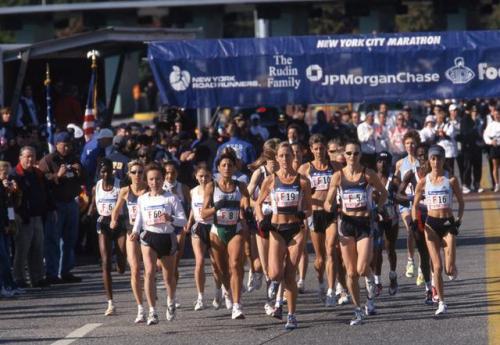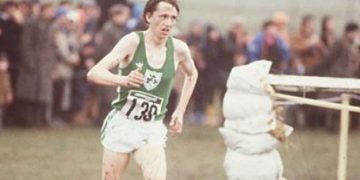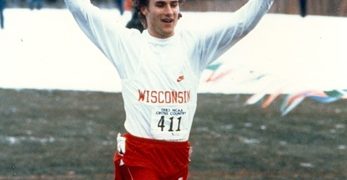PHOTO: The elite women starting the 2002 New York City Marathon (from left to right): F6, Joyce Chepchumba (KEN); F9, Kerryn McCann (AUS); F60, Silvia Skvortsova (RUS/pacemaker); F8, Maria Guida (ITA); F19, Kim Fitchen-Young (USA); F10, Marla Runyan (USA); F5, Sonia O’Sullivan (IRL); F16, Milena Glusac (USA). Photo by PhotoRun; used with permission from New York Road Runners), used with permission.
Here’s Rich Sands’ piece on TCS NYCM and its support of women’s running. The story helps put NYCM and the history of women’s running into perspective.
FIFTEEN YEARS AGO, THE TCS NEW YORK CITY MARATHON PUT WOMEN FIRST
By Rich Sands, @sands
(c) 2017 Race Results Weekly, all rights reserved, used with permissionNEW YORK (31-Oct) — Nina Kuscsik. Kathrine Switzer. Grete Waitz. Tegla Loroupe. Paula Radcliffe. Mary Keitany.
The TCS New York City Marathon has a long history of showcasing iconic women’s distance runners. But for many years the female stars of the sport were getting lost in the crowd. Literally.
Through 2001, New York featured a mixed mass start, sending off the elite women simultaneous with the top men and the hordes of rank and file runners. While that format frequently helped the leading women clock impressive times, it often came at the expense of visibility and even fair play. “What was happening is that we couldn’t see the women in the TV show because inevitably fast guys who weren’t going to win the race would be running all around them and it was easy for them to get lost,” says Mary Wittenberg, who was executive vice president of New York Road Runners, the race organizers, at the time (she later served as president and CEO from 2005-2015 and is currently the global CEO of Richard Branson’s Virgin Sport).
So in keeping with its long history of women’s empowerment, NYRR made the bold move in 2002 of giving the top women a 35-minute head start on the field. “Instead of having all runners start together, the professional women began earlier in order to ensure they received their fair share of the spotlight and to promote fair head-to-head competition,” says Peter Ciaccia, NYRR’s president for events and race director for the marathon.
Fifteen years later, the concept has become familiar. But it was revolutionary at the time. Though women had been racing solo in championship events like the Olympics since the 1980s, it was common in major city races to have a mixed mass start. Still, NYRR had already set the proverbial pace towards the move. In 1972 the club staged the first ever women’s only road race, the Crazylegs Mini Marathon, a 6-miler in Central Park. “Something like putting women out front is so dead on what New York Road Runners stands for, that that was simple,” Wittenberg says. “It was so in line with our history and our role in the sport.”
The suggestion first came up during a discussion between Lornah Kiplagat and NYRR’s then-CEO, Allan Steinfeld, following the 2002 edition of the NYRR Mini 10K (the descendant of the Crazylegs race), where Kiplagat finished second. (She would return to the city that November and finish 7th in her NYC Marathon debut.) They shared the idea with Wittenberg, who recalls, “It was almost a snap decision. There was a lot of debate, but it was quick.”
The shift quickly caught the attention of the running community. “It was kind of a provocative move for New York,” says Deena Kastor, the American record holder in the marathon and the 2004 Olympic bronze medalist. Kastor didn’t run the event that year, but competed in New York both before and after the change. “It was beautiful to be able to hear the TV commentators talk about all the women in the lead and to talk mindfully about strategy.”
While hindsight has proven the decision a success, there were concerns at the time, particularly the fear that the field might get so strung out that some women could end up running alone, caught in the proverbial “no man’s land.” To buffer that, NYRR brought in a larger than usual field of elite women.
Another major question mark was whether the women’s race might not be as quick as usual without the boost of running alongside men. After all, Kenyan Margaret Okayo had lowered the event record to 2:24:21 just the year before.
And when the 2002 race set out on a relatively conservative pace–the leaders hit halfway in 1:14:12–organizers were on the edge of their seats. The pace gradually increased and finally, in the 23rd mile, Joyce Chepchumba made a decisive move to secure the win, coming home in a respectable 2:25:56, 21 seconds ahead of Russian Lyubov Denisova. “It’s right to run with only women,” the Kenyan said after scoring her first New York victory, following three previous Top 5 finishes. “We can keep watching one another.”
The decision was further reinforced a year later when Okayo lowered her event record to 2:22:31 (which still stands), an impressive clocking on New York’s notoriously challenging route.
Kastor, who made her marathon debut in New York in 2001, returned in 2006 and saw the change as the best of both worlds. “In my track specialties, the 5K and 10K, it feels like you are performing for people and in the marathon in the mass start, it feels like you are running with people–it feels more of a community than it does a performance,” she remembers. “By having the women race separately I thought, wow, that’s a really good combination of the two.”
The idea quickly caught on around the world. By 2004, both the Boston and London marathons featured a women’s only start. (The other three Abbott World Marathon Majors events, Berlin, Chicago and Tokyo, still feature a mixed mass start.) “Ultimately we were leaning into who we really were,” Wittenberg says. “New York Road Runners has always stood for the belief that women are just as tough, at minimum, as the men and can handle the big open streets.”
This year the women will have a 30-minute head start when the race goes off on Sunday, November 5. “Some of the biggest names in the sport, including world record-holder and three-time defending champion Mary Keitany and Olympic medalist Shalane Flanagan, will enjoy that spotlight this year,” Ciaccia says. The telecast begins at 9:00 a.m./ET on ESPN2 (and streaming via WatchESPN) with local coverage in the New York City area on WABC-TV (channel 7).
Author
Race Results Weekly is the news service of record for global road racing, published by David and Jane Monti, with support of Chris Lotsbom. RunBlogRun publishes their stories with permission.
View all posts





















